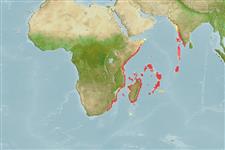Environment: milieu / climate zone / depth range / distribution range
Ecologia
marinhas demersal; intervalo de profundidade 40 - 507 m (Ref. 86966). Subtropical
Western Indian Ocean: South Africa, Madagascar, the Seychelles and Réunion.
Tamanho / Peso / Idade
Maturity: Lm ? range ? - ? cm
Max length : 21.6 cm SL macho/indeterminado; (Ref. 86966)
Descrição suscinta
Chaves de identificação | Morfologia | Morfometria
Espinhos dorsais (total) : 12; Raios dorsais (total) : 9 - 11; Espinhos anais: 3; Raios anais : 5; Vértebras: 26. This species is characterized by the following: D XII, 9-11 (usually 10); A III,5; pelvic-fin rays I,5; pectoral-fin rays 18 on each side of body (asymmetrically 17 and 18 in one specimen); Longitudinal scale series 32-37; pored lateral-line scales 23-25 (usually 25); scale rows above lateral line 4-5 (usually 5) and below 10; scale rows between last dorsal-fin spine base and lateral line 4-5 (usually 5); 6 scale rows between sixth dorsal-fin spine base and lateral line; 6-8 predorsal scales; gill rakers on upper limb 5-7, lower limb 12-13, total 17-20 (usually 18); 26 vertebrae (based on MNHN 2003-291); head length 45.9-48.6% of SL; orbit diameter 12.0-17.1% of SL (value significantly decreasing with growth); interorbital width at middle of eye 4.4-5.8% of SL; lateral lacrimal spine absent; anterior lacrimal spine rounded, not spinous shape; posterior lacrimal spine triangular; suborbital spines 4-8; preopercular spines 5, with an additional spine on uppermost spine; preocular, supraocular, postocular, and tympanic spines are well developed; interorbital ridges joined posteriorly to tympanic spine bases; no parietal spine; the large and well developed nuchal spine originating from posterior end of tympanic spine; absence of interorbital, coronal and pretympanic spines; occiput nearly flat, without pit; sphenotic spines 2-13; parietal, lower posttemporal and supracleithral spines well developed; no upper posttemporal spine, but a small spine occurring between nuchal and lower posttemporal spines; posterior margin of maxilla just short of or reaching a vertical through posterior margin of orbit; with teeth on vormer and palatines; pectoral fin bilobed; usually a large black blotch on dorsal fin basally between fifth-seventh and tenth spines (lacking the blotch in some specimens); body is strongly mottled, especially dorsally (Ref. 86966).
Ciclo de vida ou comportamento de acasalamento
Maturities | Reprodução | Spawnings | Egg(s) | Fecundities | Larvas
Motomura, H., P. Béarez and R. Causse, 2011. Review of Indo-Pacific specimens of the subfamily Scorpaeninae (Scorpaenidae), deposited in the Muséum national d’Histoire naturelle, Paris, with description of a new species of Neomerinthe. Cybium 35(1):55-73. (Ref. 86966)
Status na Lista Vermelha da UICN (Ref. 130435)
Ameaça para os humanos
Harmless
Uso pelos humanos
Ferramentas
Relatórios especiais
Baixar XML
Fontes da internet
Estimates based on models
Preferred temperature (Ref.
123201): 15.3 - 17.9, mean 16.8 °C (based on 4 cells).
Índice de diversidade filogenética (Ref.
82804): PD
50 = 1.0000 [Uniqueness, from 0.5 = low to 2.0 = high].
Bayesian length-weight: a=0.01259 (0.00606 - 0.02615), b=3.03 (2.86 - 3.20), in cm total length, based on LWR estimates for this (Sub)family-body shape (Ref.
93245).
Nível Trófico (Ref.
69278): 3.9 ±0.5 se; based on size and trophs of closest relatives
Resiliência (Ref.
120179): médio(a), tempo mínimo de duplicação da população 1,4 - 4,4 anos (Preliminary K or Fecundity.).
Fishing Vulnerability (Ref.
59153): Low vulnerability (16 of 100).
